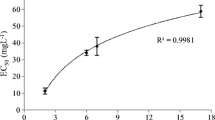Abstract
The ultimate aerobic biodegradability and toxicity of three ether carboxylic derivative surfactants having different alkyl chains and degrees of ethoxylation were investigated. Ultimate aerobic biodegradability was screened by means of dissolved organic carbon determinations at different initial surfactant concentrations. For comparison, the characteristic parameters of the biodegradation process, such as half-life, mean biodegradation rate, and residual surfactant concentration, were determined. Increased surfactant concentrations decreased mineralization and lengthened the estimated half-life. The results demonstrate that the ultimate aerobic biodegradability is higher for the surfactants with the shortest alkyl chain and highest degree of ethoxylation. Toxicity values of the surfactants, and their binary mixtures, were determined using three test organisms, the freshwater crustacea Daphnia magna, the luminescent bacterium Vibrio fischeri and the microalgae Selenastrum capricornutum. The toxicity is lower for the surfactants with the shortest alkyl chain and highest degree of ethoxylation. The toxicity of binary mixtures of the three ether carboxylate surfactants at a 1:1 weight ratio was also measured. The least toxic mixture is formed by the surfactants having lower individual toxicity.



Similar content being viewed by others
References
Scheibel J (2004) The evolution of anionic surfactant technology to meet the requirements of the laundry detergent industry. J Surfact Deterg 7:319–328
Aloui F, Kchaou S, Sayadi S (2009) Physicochemical treatments of anionic surfactants wastewater: effect on aerobic biodegradability. J Hazard Mater 164:353–359
Cain RB (1994) Biodegradation of detergents. Curr Opin Biotechnol 5:266–274
Steber J, Guhl W, Steker N, Schröder F (1995) Alkyl polyglycosides – ecological evaluation of a new generation of nonionic surfactants. Tenside Surf Deterg 32:515–521
Brownawell BJ, Chen H, Zhang W, Westall JC (1997) Sorption of non-ionic surfactants on sediment materials. Environ Sci Technol 31:1735–1741
Fytianos K, Voudrias E, Papamichali A (1998) Bahaviour and fate of linear alkylbenzene sulfonate in different soils. Chemosphere 36:2741–2746
Scott MJ, Jones MN (2000) The biodegradation of surfactants in the environment. Biochim Biophys Acta 1508:235–251
García MT, Campos E, Sánchez-Leal J, Ribosa I (1999) Effect of the alkyl chain length on the anaerobic biodegradability and toxicity of quaternary ammonium based surfactants. Chemosphere 38:3473–3483
Charles W, Ho G, Cord-Ruwisch R (1996) Anaerobic biofloculation of wool scouring effluent: the influence of non-ionic surfactants on efficiency. Water Sci Technol 34:1–8
Ying GG (2005) Fate, behavior and effects of surfactants and their degradation products in the environment. Environ Int 32:417–431
Lewis M, Wee V (1991) Chronic and sublethal toxicities of surfactants to aquatic animals: a review and risk assessment. Water Res 25:101–113
Liwarska-Bizukocj E, Miksch K, Malachowska-Jutsz A, Kalka J (2005) Acute toxicity and genotoxcity of five selected anionic and non-ionic surfactants. Chemosphere 58:1249–1253
White GF, Russel NJ (1993) Biodegradation of anionic surfactants and related molecules. In: Ratledge C (ed) Biochemistry of microbial degradation. Kluwer, Dordrecht, pp 143–177
Yu Y, Zhao J, Bayly A (2008) Development of surfactants and builders in detergent formulations. Chin J Chem Eng 16:517–527
Organisation for Economic Cooperation and Development (OECD) (1993) OECD guidelines for the testing of chemicals volume 1 Section 3: degradation and accumulation, OECD, Paris, France
UNE EN ISO 11348-2 (NORMA UNE EN ISO 11348-2). Determinación del efecto inhibidor de muestras de agua sobre la luminiscencia de Vibrio fischeri (Ensayo de bacterias luminiscentes)
UNE EN ISO 6341 (NORMA UNE EN ISO 6341). Determinación de la inhibición de la movilidad de Daphnia magna Straus (Cladocera, Crustacea) (Ensayo de toxicidad aguda)
Organisation for Economic Cooperation and Development (OECD) (1984) OECD guidelines for the testing of chemicals. Alga growth inhibition test, OECD, Paris, France
Jurado E, Fernández-Serrano M, Núñez-Olea J, Luzón G, Lechuga M (2006) Simplified spectrophotometric method using methylene blue for determining anionic surfactants: Applications to the study of primary biodegradation in aerobic screening tests. Chemosphere 65:278–285
Belanger S, Dorn P, Toy R, Boeije G, Marshall S, Wind T, Van Compernolle R, Zeller D (2006) Aquatic risk assessment of alcohol ethoxylates in North America and Europe. Ecotoxicol Environ Saf 64:85–99
Van Compernolle R, McAvoy D, Sherren A, Wind T, Cano M, Belanger S, Dorn P, Kerr K (2006) Predicting the sorption of fatty alcohols and alcohol ethoxylates to effluent and receiving water solids. Ecotoxicol Environ Saf 64:61–74
Jurado E, Fernández-Serrano M, Núñez-Olea J, Lechuga M (2007) Primary biodegradation of commercial fatty-alcohol ethoxylate surfactants: characteristic parameters. J Surfact Deterg 10:145–153
EC Regulation (2004) Regulation (EC) No 648/2004 of the European Parliament and the Council of 31 March 2004 on detergents. (DO L 104, 04/08/2004)
European Economic Community (EEC). Council Directive of 27 June 1967 on the approximation of laws, regulations and administrative provisions relating to the classification, packaging and labelling of dangerous substances (67/548/EEC)
Pettersson A, Adamsson M, Dave G (2000) Toxcity and detoxification of Swedish detergents and softener products. Chemosphere 41:1611–1620
Szwach I, Hreczvch W and Fochtman P (2002) Comparative evaluation of environmental impact of fatty alcohol ethoxylates and fatty acid methyl ester ethoxylates as nonionic surfactants. In: A Chain (ed) Proceedings of the 5th world conference on detergents: reinventing the industry—opportunities and challenges. Montreux, Switzerland, pp 163–165
Author information
Authors and Affiliations
Corresponding author
About this article
Cite this article
Jurado, E., Fernández-Serrano, M., Lechuga, M. et al. Environmental Impact of Ether Carboxylic Derivative Surfactants. J Surfact Deterg 15, 1–7 (2012). https://doi.org/10.1007/s11743-011-1278-z
Received:
Accepted:
Published:
Issue Date:
DOI: https://doi.org/10.1007/s11743-011-1278-z




